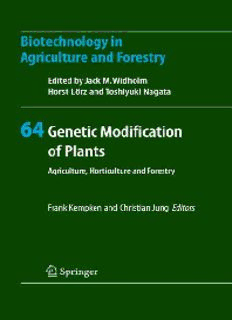
Genetic Modification of Plants: Agriculture, Horticulture and Forestry PDF
Preview Genetic Modification of Plants: Agriculture, Horticulture and Forestry
Biotechnology in Agriculture and Forestry Volume 64 Series Editors Prof. Dr. Jack M. Widholm (Managing Editor) 285A E.R. Madigan Laboratory, Department of Crop Sciences, University of Illinois, 1201 W. Gregory,Urbana, IL 61801, USA Prof. Dr. Horst Lo¨rz Biozentrum Klein Flottbek,Molekulare Phytopathologie und Genetik, Universita¨t Hamburg, Ohnhorststr. 18, 22609 Hamburg, Germany Prof. Dr. Toshiyuki Nagata ProfessorandDean,FacultyofBiologicalSciencesandAppliedChemistry, Hosei University,3-7-2 Kajino-cho, Koganei-shi, Tokyo 184-8584, Japan; Emeritus Professor of the University of Tokyo, 7-3-1 Hongo, Bunkyo-ku, Tokyo 113-0033,Japan Biotechnology in Agriculture and Forestry Further volumes can be found at springer.com. Volume31:SomaticEmbryogenesisandSyntheticSeedII(1995) Volume32:CryopreservationofPlantGermplasmI(1995) Volume33:MedicinalandAromaticPlantsVIII(1995) Volume34:PlantProtoplastsandGeneticEngineeringVI(1995) Volume35:TreesIV(1996) Volume36:SomaclonalVariationinCropImprovementII(1996) Volume37:MedicinalandAromaticPlantsIX(1996) Volume38:PlantProtoplastsandGeneticEngineeringVII(1996) Volume39:High-TechandMicroprogationV(1997) Volume40:High-TechandMicroprogationVI(1997) Volume41:MedicinalandAromaticPlantsX(1998) Volume42:Cotton(1998) Volume43:MedicinalandAromaticPlantsXI(1999) Volume44:TransgenicTrees(1999) Volume45:TransgenicMedicinalPlants(1999) Volume46:TransgenicCrops1I(1999) Volume47:TransgenicCropsII(2001) Volume48:TransgenicCropsIII(2001) Volumes1–48wereeditedbyY.P.S.Bajaj† Volume49:SomaticHybridizationinCropImprovementII(2001) T.NagataandY.P.S.Bajaj(Eds.) Volume50:CryopreservationofPlantGermplasmII(2002) L.E.TowillandY.P.S.Bajaj(Eds.) Volume51:MedicinalandAromaticPlantsXII(2002) T.NagataandY.Ebizuka(Eds.) Volume52:BrassicasandLegumes:FromGenomeStructuretoBreeding(2003) T.NagataandS.Tabata(Eds.) Volume53:TobaccoBY-2Cells(2004) T.Nagata,S.Hasezawa,andD.Inze´(Eds.) Volume54:Brassica(2004) E.C.PuaandC.J.Douglas(Eds.) Volume55:MolecularMarkerSystemsinPlantBreedingandCropImprovement(2005) H.Lo¨rzandG.Wenzel(Eds.) Volume56:HaploidsinCropImprovementII(2005) C.E.Palmer,W.A.Keller,andK.J.Kasha(Eds.) Volume57:PlantMetabolomics(2006) K.Saito,R.A.Dixon,andL.Willmitzer(Eds.) Volume58:TobaccoBY-2Cells:FromCellularDynamicstoOmics(2006) T.Nagata,K.Matsuoka,andD.Inze´(Eds.) Volume59:TransgenicCropsIV(2007) E.C.PuaandM.R.Davey(Eds.) Volume60:TransgenicCropsV(2007) E.C.PuaandM.R.Davey(Eds.) Volume61:TransgenicCropsVI(2007) E.C.PuaandM.R.Davey(Eds.) Volume62:RiceBiologyintheGenomicsEra(2008) H.-Y.Hirano,A.Hirai,Y.SanoandT.Sasaki(Eds.) Volume63:MolecularGeneticApproachestoMaizeImprovement(2009) A.L.KrizandB.A.Larkins(Eds.) Volume64:GeneticModificationofPlants:Agriculture,HorticultureandForestry(2010) F.KempkenandC.Jung(Eds.) Frank Kempken Christian Jung l Editors Genetic Modification of Plants Agriculture, Horticulture and Forestry Editors Prof.Dr.FrankKempken Prof.Dr.ChristianJung InstituteofBotanyandBotanicalGarden PlantBreedingInstitute ChristianAlbrechtsUniversityofKiel ChristianAlbrechtsUniversityofKiel Olshausenstr.40 Olshausenstr.40 24098Kiel,Germany 24098Kiel,Germany [email protected] [email protected] ISSN0934-943X ISBN978-3-642-02390-3 e-ISBN978-3-642-02391-0 DOI10.1007/978-3-642-02391-0 SpringerHeidelbergDordrechtLondonNewYork LibraryofCongressControlNumber:2009933124 #Springer-VerlagBerlinHeidelberg2010 Thisworkissubjecttocopyright.Allrightsarereserved,whetherthewholeorpartofthematerialis concerned,specificallytherightsoftranslation,reprinting,reuseofillustrations,recitation,broadcasting, reproductiononmicrofilmorinanyotherway,andstorageindatabanks.Duplicationofthispublication orpartsthereofispermittedonlyundertheprovisionsoftheGermanCopyrightLawofSeptember9, 1965,initscurrentversion,andpermissionforusemustalwaysbeobtainedfromSpringer.Violations areliabletoprosecutionundertheGermanCopyrightLaw. Theuseofgeneraldescriptivenames,registerednames,trademarks,etc.inthispublicationdoesnot imply, even in the absence of a specific statement, that such names are exempt from the relevant protectivelawsandregulationsandthereforefreeforgeneraluse. Coverdesign:SPiPublisherServices Printedonacid-freepaper SpringerispartofSpringerScience+BusinessMedia(www.springer.com) This book is dedicated to Prof. Dr. Dr. h.c. mult. Gerhard Ro¨bbelen on the occasion of his 80th birthday for his lifetime contribution to applied plant genetics. Preface Today modern agriculture is facing new challenges. Total yields have to be increasedduetothecontinuingpopulationgrowthofmankindandduetochanging food consumption. However, global climate creates new problems but also new opportunitiesforagriculture.Formorethanadecadetheyearlyyieldincreasesof majorfoodstapleshavebeenonthedecline,whichisduetooptimizedproduction systemsliketheapplicationofmineralfertilizerandcropprotectionmeasures.But alsotheyieldincreasesduetogeneticimprovementofcropshavebeenstagnating. Obviouslyweareapproachingyieldbarriersforanumberofcrops,whichcreatesa needforinnovationinbreedingsystems. There is no doubt that further genetic improvement of crops will be a key for increasing yields in the future. Moreover, breeding must meet the demands for increasingbiomass(bioenergy)andtheproductionofindustrialrawmaterials.The breeding of better-adapted and higher-yielding varieties relies crucially on the available genetic variation. Broad genetic variation is a fundamental prerequisite forsuccessfulbreeding.Apartfromothertechnologieslikewidecrosses,mutation breeding and somatic hybridization, genetically modified plants will play an in- creasinglyimportantroleinfuturebreedingsystemseitherbecausenaturalgenetic variation has been largely exploited or because natural variation is completely lacking from the primary and secondary or even from the tertiary gene pool of a cropspecies. Itiscommonlyagreedwithinthescientificcommunitythatgeneticallymodified plants will be important for future breeding. Adoption rates worldwide have been increasinginthepasttenyearsinabreathtakingmanner.Intheyear2008geneti- callymodifiedplantswerecultivatedbyabout13.3miofarmersfrom25countries worldwideonatotalacreageofabout125mioha(http://www.isaaa.org/).Numer- ousinvestigationshaveconfirmedthatcultivationofgeneticallymodifiedplantsis safe,asfarasapprovedplantsareconcernedwhichhavepassedastepbysteprisk assessment procedure, as is commonly applied in most countries growing geneti- cally modified organisms (GMO) today. Instead of this, there is still a big public debateonGMplantsinanumberofcountries.MainlyintheEuropeanUnion,the productionofGMplantsisalmostcompletelyavoided.Lowconsumeracceptance vii viii Preface istheonlyreasonpointedoutbypoliticianstoestablishlegalrestrictionsforGMO production, inspite ofnumerous studies confirming their safety towards the envi- ronmentorforfoodandfeeduse.Manyscientistshavebeenfrustratedduetothis debate which is ignoring scientific facts and which is mainly directed by pressure groupsandnon-governmentalorganizations. Thisbookwaswrittenwithanintentiontogetbacktothefacts.Inthepastyears a number of books focusing on GM plants have been published. Some of these coverallaspects,includingminorcropspecies.So,whyisthere aneed foranew book?OurbooktriestoaddressallaspectsofGMplants,includingtheiremploy- mentinaplant-breedingprocedure,andtheirsocioeconomicimplications.Wetry toemphasizethatGMplantsamongothersareanimportanttoolinplantbreeding tobroadenthegeneticvariationofcropspecies. Thebookisstructuredintofourparts.Thefirstpartdealswithtechnicaldetails ofplantgeneticengineering. Thesecondpart introduces charactersofGMplants, while the third part presents applications in agricultural production systems. The lastpartdealswithriskassessmentandeconomicimplications,whichareimportant aspects of GM plants. The articles are written by scientists who have a long experience in their field of expertise. We thank the authors for their excellent contributions,whichmakethisbook,wethink,avaluableresourceforthedifferent aspects ofGMcrops.Weare aware ofthe fact thatnotalltopics andsomeminor cropscouldnotbeincludedinthisbook.Weregretthatthiswasnotpossibledueto size limitations. Finally we are indebted to the Springer publishing company for supportingthisbook. Kiel,Germany FrankKempkenandChristianJung October2009 Contents PartA GenerationandAnalysisofTransgenicPlants 1 PlantNuclearTransformation .............................................. 3 JohnJ.Finer 1.1 IntroductiontoPlantTransformation ................................. 3 1.1.1 DNAIntroductionBasics ....................................... 3 1.2 TransientExpression .................................................. 4 1.2.1 OptimizationofTransientExpression ......................... 5 1.2.2 TransientExpressiontoStudyGene ExpressionandStability ........................................ 5 1.3 AgrobacteriumBackground ........................................... 6 1.3.1 AStringofImprovementsforAgrobacterium ................. 7 1.3.2 Agrobacterium–PlantInteractions ............................. 8 1.3.3 ReducingAgents ............................................... 8 1.3.4 Agroinfiltration ................................................. 9 1.3.5 ArabidopsisFloralDip ......................................... 9 1.4 ParticleBombardment ................................................. 10 1.4.1 GeneGuns ...................................................... 11 1.4.2 OptimizationofDNADelivery ................................ 11 1.4.3 ControlofDNAIntegrationPatterns ........................... 12 1.5 OtherDirectDNAUptakeApproaches ................................ 12 1.5.1 Protoplasts ...................................................... 13 1.5.2 WholeTissueElectroporation .................................. 13 1.5.3 SiliconCarbideWhiskers ...................................... 14 1.5.4 NanofiberArrays ............................................... 14 1.5.5 PollenTubePathway ........................................... 15 1.6 EvidenceforTransformation .......................................... 16 1.6.1 DNAPresence .................................................. 16 1.6.2 GeneExpression ................................................ 17 1.7 Conclusions ............................................................ 18 References .................................................................. 18 ix
Description: